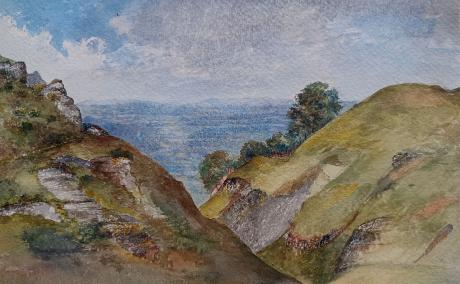as title
The Central Worcestershire Plain is characterised by mixed farming settlements or hamlets usually comprising dispersed rows or loosely clustered groupings of farmsteads and houses. Many settlements have large scale farmsteads which developed on enlarged plots from the medieval period. There is also extensive evidence for shrunken settlement which in the medieval period related to extensive areas of both strip fields and common land. Areas with irregular fields intermixed with ancient woodland are associated with wayside cottages, many dating to the 18th century or earlier, and have the highest densities of dispersed farmsteads, often clustered close together and dating from the medieval period. Such settlements are characterised by loose clusters of farmsteads that dominate the character of settlement, with just a few wayside cottages interspersed with the farmsteads. Areas with lower densities typically result from the amalgamation of farms and the activities of estates, this being reflected in larger scale farmsteads and fields with scattered outfarms and 19th century farm workers cottages. Larger villages typically result from 19th century and later expansion. 61% of sites are considered to have high heritage potential; 30% of sites have some heritage potential.
An area of mixed farming combined with hops (concentrated in the Teme Valley) and fruit growing, where farmland was intermixed with scattered woodland and large areas of common land. There are high numbers of 18th-century and earlier houses and working buildings, relating to medieval and later patterns of dispersed settlement which mostly relate to intricate networks of lanes. These include moated sites of the 14th century and earlier that are concentrated in a north/south band west of the Severn and more broadly throughout the former Feckenham Forest area in central eastern and northeast Worcestershire. Farming settlements or hamlets usually comprise dispersed rows or loosely clustered groupings of farmsteads and houses, many settlements having large-scale farmsteads that developed on enlarged plots from the medieval period. There is also extensive evidence for shrunken settlements which in the medieval period related to extensive areas of both strip fields and common land. Areas with irregular fields intermixed with ancient woodland are associated with wayside cottages, many of the 18th century or earlier date, and have the highest densities of dispersed farmsteads, often clustered close together and dating from the medieval period. Such settlements are characterized by loose clusters of farmsteads that dominate the character of the settlement, with just a few wayside cottages interspersed with the farmsteads. Areas with lower densities typically result from the amalgamation of farms and the activities of estates, this being reflected in larger-scale farmsteads and fields, with scattered outfarms and 19th-century farm workers’ cottages. Larger villages typically result from the 19th century and later expansion. Large to medium scale courtyard plan farmsteads, with multiple yards or buildings to all sides of the main yard, developed in relationship to larger-scale enclosures and are intermixed with a strong underpinning number of small-scale farms (notably linear and L-plan (house attached), smaller loose courtyard, L plans, and dispersed clusters) and smallholdings which developed around the Malverns, in patches of the small-scale irregular enclosure, around large commons which remained into the 20th century (for example in the Castlemorton area) and the hills of the Teme Valley. Within and extending from the Teme Valley towards Worcester are dispersedplan farmsteads which probably relate to ancient driftways and areas for moving and holding stock.
Mary Keightley (1854-1946) was the youngest daughter of Archibald Keightley (1795-1877), executor of Sir Thomas Lawrence’s estate. She was a good amateur artist. Archibald Keightley (1795-1877), who was a solicitor who was the executor for Sir Thomas Lawrence, who had died earlier in 1830. Mr Keightley was responsible for the sale of Sir Thomas's collections, some of which were not paid for! There is a very interesting story about Sir Thomas's collection of old master drawings which were part of the assets Mr Keightley had to dispose of. Following his work as a solicitor, Mr Keightley a few years later became the Registrar for the Charterhouse School, where he remained for 39 years.
Mary Keightley was born in 1854, in Charterhouse, Middlesex, England, United Kingdom, her father, Archibald Keightley, was 58 and her mother, Sarah Elizabeth Yates, was 41. She lived in London, England for about 20 years and Royal Borough of Kensington and Chelsea, London, England, United Kingdom in 1891. She died on 20 April 1946, in Camberley, Surrey, England, United Kingdom, at the age of 93.

